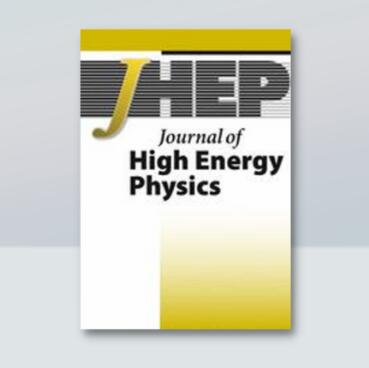正则微分方程和相对上同调的选择规则注释
IF 5.5
1区 物理与天体物理
Q1 Physics and Astronomy
引用次数: 0
摘要
利用(n+1)-d对数形式在n-d对数形式上的投影,给出了典型微分方程系数矩阵的-d对数形式的解释。这个投影是用交点数的首阶公式完成的。这个公式给出了一种计算系数矩阵的简单方法。当与相对扭上同调相结合时,可以避免使用调节器方法计算的冗余。本文章由计算机程序翻译,如有差异,请以英文原文为准。
Notes on selection rules of canonical differential equations and relative cohomology
We give an explanation of the d log-form of the coefficient matrix of canonical differential equations using the projection of (n+1)-d log forms onto n-d log forms. This projection is done using the leading-order formula for intersection numbers. This formula gives a simple way to compute the coefficient matrix. When combined with the relative twisted cohomology, redundancy in computation using the regulator method can be avoided.
求助全文
通过发布文献求助,成功后即可免费获取论文全文。
去求助
来源期刊

Journal of High Energy Physics
物理-物理:粒子与场物理
CiteScore
10.30
自引率
46.30%
发文量
2107
审稿时长
1.5 months
期刊介绍:
The aim of the Journal of High Energy Physics (JHEP) is to ensure fast and efficient online publication tools to the scientific community, while keeping that community in charge of every aspect of the peer-review and publication process in order to ensure the highest quality standards in the journal.
Consequently, the Advisory and Editorial Boards, composed of distinguished, active scientists in the field, jointly establish with the Scientific Director the journal''s scientific policy and ensure the scientific quality of accepted articles.
JHEP presently encompasses the following areas of theoretical and experimental physics:
Collider Physics
Underground and Large Array Physics
Quantum Field Theory
Gauge Field Theories
Symmetries
String and Brane Theory
General Relativity and Gravitation
Supersymmetry
Mathematical Methods of Physics
Mostly Solvable Models
Astroparticles
Statistical Field Theories
Mostly Weak Interactions
Mostly Strong Interactions
Quantum Field Theory (phenomenology)
Strings and Branes
Phenomenological Aspects of Supersymmetry
Mostly Strong Interactions (phenomenology).
 求助内容:
求助内容: 应助结果提醒方式:
应助结果提醒方式:


